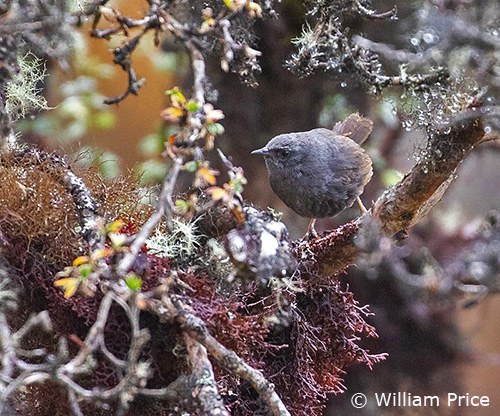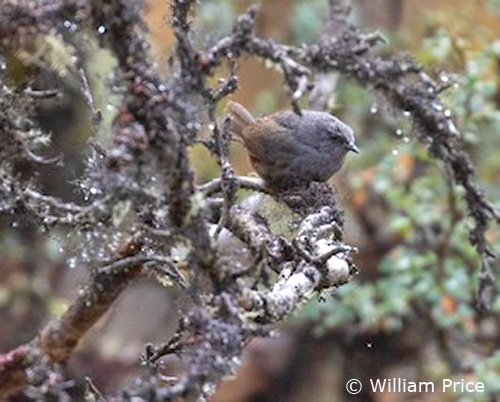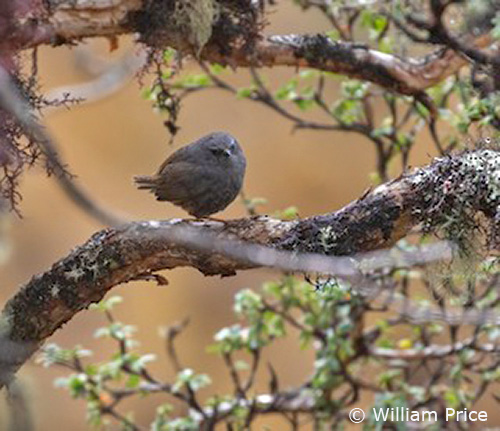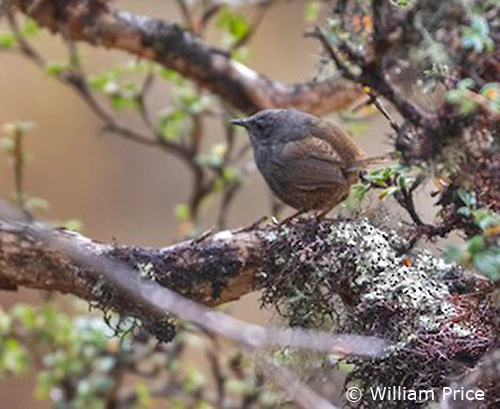
PROTECTION / THREATS / STATUS:
The Puna Tapaculo has a restricted range in which it is described as “fairly common”.
The size of the population is unknown, but the numbers are suspected to be stable.
The species is little affected by human disturbances and activities, as it occurs at high elevation in the Andes.
The Puna tapaculo is currently evaluated as Least Concern.
Fr: Mérulaxe de Simons
Ang: Puna Tapaculo - Andean Tapaculo
All: Punatapaculo
Esp: Churrín de la Puna
Ita: Tapaculo della puna
Nd: Simons' Tapaculo
Sd: punatapakul
Photographers:
Roger Ahlman
Pbase Galleries Peru and Ecuador
William Price
PBase-tereksandpiper & Flickr William Price
Text by Nicole Bouglouan
Sources:
HANDBOOK OF THE BIRDS OF THE WORLD Vol 8 By Josep del Hoyo-Andrew Elliott-David Christie - Lynx Edicions - ISBN: 8487334504
BIRDS OF SOUTH AMERICA – Passerines - by Robert S. Ridgely and Guy Tudor – HELM Field Guides – ISBN: 9781408113424
A GUIDE TO THE BIRDS OF COLOMBIA by Steven L. Hilty and William L. Brown - Princeton University Press – ISBN 069108372X
Nest, eggs, and parental care of the Puna Tapaculo (Scytalopus simonsi)
Fat birder - Rhinocryptidae – Tapaculos
CREAGUS@Monterey Bay (Don Roberson)
Wikipedia, la enciclopedia libre
Wikipedia, the free encyclopaedia
Puna Tapaculo
Scytalopus simonsi
Passeriformes Order – Rhinocryptidae Family
INTRODUCTION:
The Puna Tapaculo occurs from SE Peru, E to C Bolivia. It is found at high elevations, from 2,900 to 4,300 metres in the Andes. It frequents the elfin forest at tree line, small shrubs and trees, and Polylepis woodlands. It is primarily terrestrial and feeds mainly on the ground by hopping while searching for arthropods and grass seeds.
This species builds a cup-shaped nest at the end of an excavated or abandoned burrow, near the top of a steep bank. Both adults share the nesting duties.
The story of the Puna Tapaculo is somewhat complex. It was first described as a species in 1917, but later, it was treated as synonymous of the Tschudi's Tapaculo. Still later, it was considered a subspecies of the Magellanic Tapaculo. It was finally elevated to species status in 1997, because differences in their vocalizations.
The name of the species pays tribute to Perry O. Simons, an American scientific collector (1869-1901).
The Puna Tapaculo is described as fairly common with stable numbers. It is not globally threatened at the moment.

DESCRIPTION OF THE BIRD:
Biometrics:
Length: 10-12 cm
Weight: M: 17,5 g – F: 15,7 g
Both plumage and moults of Scytalopus are very irregular, and it is rare to find two individuals that look alike.
The Puna Tapaculo is grey with a variable amount of rufous on both flanks and rump.
The adult male has grey upperparts, often with brownish wash on nape and back. The tail is dark brown to brownish-olive, with irregular dusky barring. It is short and often cocked. The upperwing is darker grey with brown/rufous flight-feathers.
On the underparts, throat and breast are grey, the throat being sometimes slightly paler. Rump, flanks, belly and undertail-coverts are dull cinnamon to pale olive-buff with dark barring.
On the grey head, we can see a narrow, whitish supercilium extending from above the eye to the back of the head.
The bill is black with paler sides of base of mandible and rictal bristles around the base.
The eyes are dark brown.
Legs and feet are pale brownish or sometimes pinkish-grey.

The adult female resembles male but she has more rufous and a very indistinct or absent supercilium.
The immature is paler overall with heavy brown wash on the upperparts. The underparts are entirely barred, and show pale grey-tipped feathers on flanks and upper belly. Flanks, rump and tail show extensive barring. This barred plumage is extremely variable.
RANGE:
The Puna Tapaculo occurs from the Andes of SE Peru (Vilcanota Mountains) Cuzco, Peru, S along the E slope of the Andes to Cochabamba in C Bolivia.
HABITAT:
The Puna Tapaculo is fairly common in dense undergrowth of the upper montane forest at tree line. It also occurs in the adjacent stunted trees and shrubs in tussock grass, and in patches of Polylepis woodland.
The species is visible between 2,900 and 4,300 metres of elevation.

CALLS AND SONGS: SOUNDS BY XENO-CANTO
The Scytalopus species are often located and identified by their vocalizations. They are mainly vocal during austral spring and summer, and less in winter.
Two calls are known for the Puna Tapaculo. First, a descending, whinny “djee-ee-ee-eer” and the second one is a two-note call “er-er”.
The song is a series of descending churred phrases “tcheer tcheer tcheer tcheer…” evenly pitched in Bolivia whereas they are rising in Peru.
They are often found in pairs, and both mates keep in vocal contact with one another.
BEHAVIOUR IN THE WILD:
The Puna Tapaculo is a terrestrial bird. It is often restless and rather fast-moving, although from time to time, it may remain motionless for many minutes.
It forages and feeds by hopping on the ground, on boulders or through the low vegetation close to ground-level.
It feeds mainly on a variety of arthropods including insects and spiders. It also takes grass seeds and soft plant material, by scratching on the ground with its pointy bill.

The breeding biology of this species is poorly known. The courtship displays are probably simple, as male and female have almost similar appearance. The short tail is certainly cocked while both mates are calling. They are strongly territorial.
During the nesting period, both adults take part in nesting duties including nest-building, incubation and parental care.
The nest is built in an excavated burrow, sometimes an abandoned tunnel in a vertical bank.
The Puna Tapaculo is resident within its range.
As a terrestrial species, it only flies over short distances. Like all tapaculos, the Puna Tapaculo is not able to perform sustained flight due to the short, very rounded wings.

REPRODUCTION OF THIS SPECIES:
The nesting behaviour is poorly known. The breeding season takes place probably during austral spring and summer.
A nest was described from an observation on 16 December in Cochabamba, Bolivia.
The nest was found at the end of a burrow, 20 cm below the top of a vertical bank. The tunnel is usually excavated by the birds themselves, although it may be sometimes an abandoned nest excavated by a rodent or another bird species.
The entrance was 9x4 cm wide, and the burrow was about 35 cm deep. Two chambers were found, the first one was empty, whereas the nest was in the second one.
The nest chamber was lined with loosely woven dried grass, forming a dome over the cup-shaped nest, lined with tightly woven grass.
Two white eggs were in the nest. The incubation was estimated at 16 days. Both adults were observed feeding the chicks with insect larvae and small insects. The fledging period was estimated at 15-20 days.
